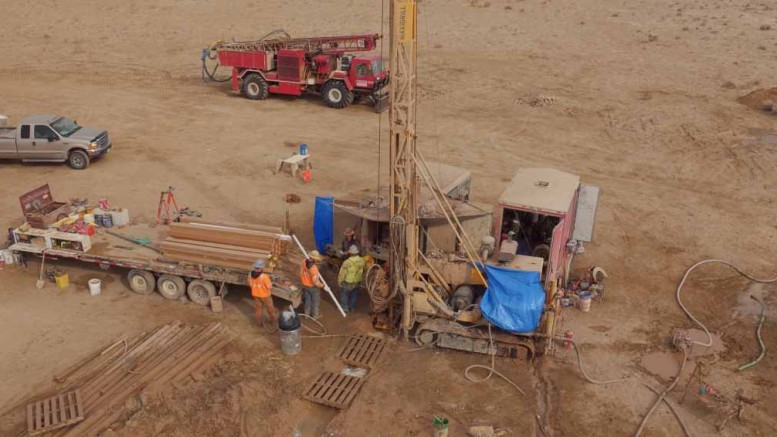VANCOUVER — Pure Energy Minerals (TSXV: PE) is testing a processing technology that could be a game changer for its Clayton Valley South lithium brine project, located beside Albemarle’s (NYSE: ALB) Silver Peak lithium mine, halfway between Reno and Las Vegas, Nev.
The mini-pilot plant work is being carried out at Tenova Bateman Technologies’ research and development centre in Katzrin, Israel, while steelmaker Posco is also conducting similar research at its facilities in Pohang, South Korea.
Chief operating officer Andy Robinson tells The Northern Miner the new processing technique would generate lithium hydroxide and slash production time.
“The old-school idea is to pump the brines out, spread it onto evaporation ponds and leave it for a year or two before it’s harvested and processed into lithium carbonate,” he says. “With this new technology, you can pump the brine to surface, run it through a chemical process, strip everything out and turn it into a battery-ready product in under two days.”
The process is broken into three phases: membranes remove the alkaline elements from the brine, such as calcium and magnesium; solvent extraction creates a lithium sulphate solution; and electrolysis converts the solution into lithium hydroxide.
The company says the technology could bump up lithium recovery within brines from 50% to greater than 99%.
“We know the process effectively extracts lithium down to 20 milligrams of lithium per litre,” he says. “If we can make this work, then what were once considered marginal brine deposits could now be completely feasible.
“The technology has been commercialized for various other metals, so we’re just taking it and tweaking a few things to make it work for lithium,” he continues. “We’ve put together this really cool brain farm, and if they can’t solve it, then it can’t be solved. But everything so far is looking good, and we have the right combination of talent to really crack this one.”
Robinson says the company became interested in the technology because getting permits to build ponds in Nevada can be “difficult,” and that “the public and regulators just don’t like evaporation ponds. They’re ugly, they require thousands of acres of public land … and you’re evaporating huge quantities of water in a desert, which is pretty reckless.”
One of Pure Energy’s biggest backers on advancing the technology is Tesla Motors (NASDAQ: TSLA).
The electric carmaker is building a US$5-billion battery plant, the “Gigafactory,” located outside Reno, and a three-hour drive from Pure Energy’s property.
The pair entered into a supply agreement last September, whereby Pure Energy would supply lithium hydroxide to Tesla over five years once Clayton Valley South goes into production and meets certain conditions.
“We saw there was something that can be done here to improve the process and Tesla agreed with us,” he says. “They’ve provided a lot of personnel and technical help to get us down this road because they believe in this technology too.”
Robinson says if the test work is successful, the company will incorporate the results into a preliminary economic study for its Clayton Valley South project, scheduled for later this year.
The report will also update the project’s inferred resource, which Robinson says was negatively impacted in the last phase of drilling. The company reported in May that drilling in the shallow part of the southern resource area returned “no significant lithium values” because a hydrothermal system was diluting the brine.
“We stepped out into the middle of the southern resource area and encountered a hydrothermal system … which is definitely not what we were expecting,” he says. “We need to recast the resource for the shallow aquifer in the south … we’re not sure how it’s going to land, but there will certainly be some impact.”
Most drilling on the project has focused on 1.6 sq. km in the northern end of the basin, where lithium-enriched brines occur in two aquifers: Main Ash and Lower.
An upper zone in the Main Ash aquifer has an inferred resource of 10,300 tonnes grading 102 milligrams of lithium per litre, whereas a lower zone has 31,700 tonnes grading 370 milligrams of lithium per litre.
The Lower aquifer system contains 163,000 tonnes grading 194 milligrams per litre.
The company combined previous drilling with seismic and gravity data to extrapolate the two lithium-bearing aquifer systems in the north across the 15 km length of the basin.
The interpretation led to the southern zone’s 30.9 sq. km inferred resource area, which measured 245,000 tonnes grading 102 milligrams per litre for the Main Ash aquifer, and 366,000 tonnes grading 37 milligrams of lithium per litre for the Lower aquifer.
Robinson explains the magnitude of the interpretation is standard practice and “the same as other inferred resources in basins across the world.”
He says that “the aquifers show up really well in the seismic section and you can see the layers go all the way through the basin just beautifully. We don’t believe the hydrothermal system impacts the entire basin. Perhaps it’s focused along some sort of fault we haven’t been able to image yet — we don’t know.”
In light of the drill results, the company is working to expand the resource in the northern end of the basin, where drilling to date has yet to reach the bottom of the brine.
“Everywhere we’ve drilled in the north looks great so far, and it’s better grade,” Robinson says. “We think by adding thickness to the north, we’ll offset some of the inferred resource we may have lost in the south, so we’re balancing two things.
“Our next milestone is to combine the new resource with the processing work in a new economic study, and if it goes the way we think it will, it will have some great numbers.”





Be the first to comment on "Pure Energy fosters ingenuity for lithium brine technology"